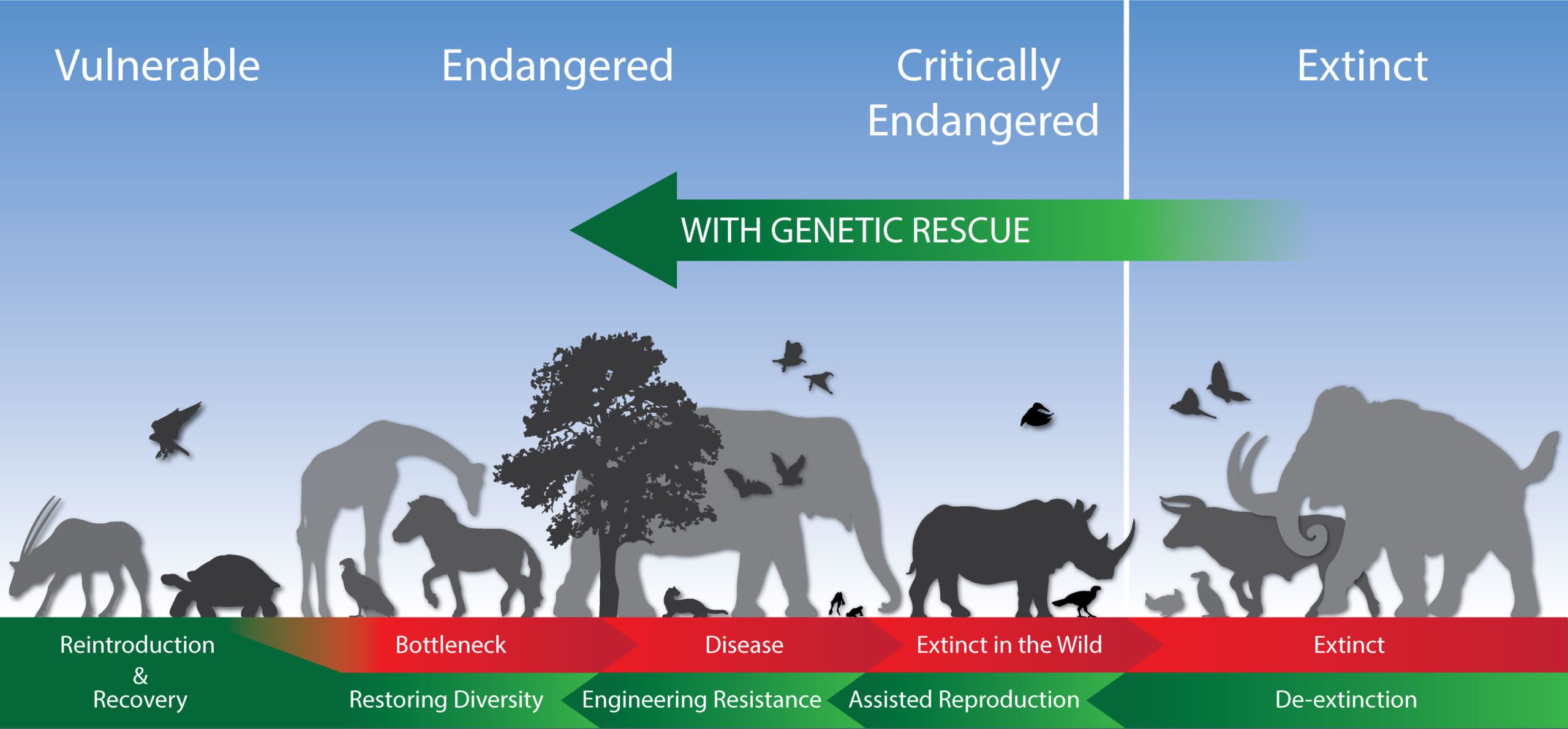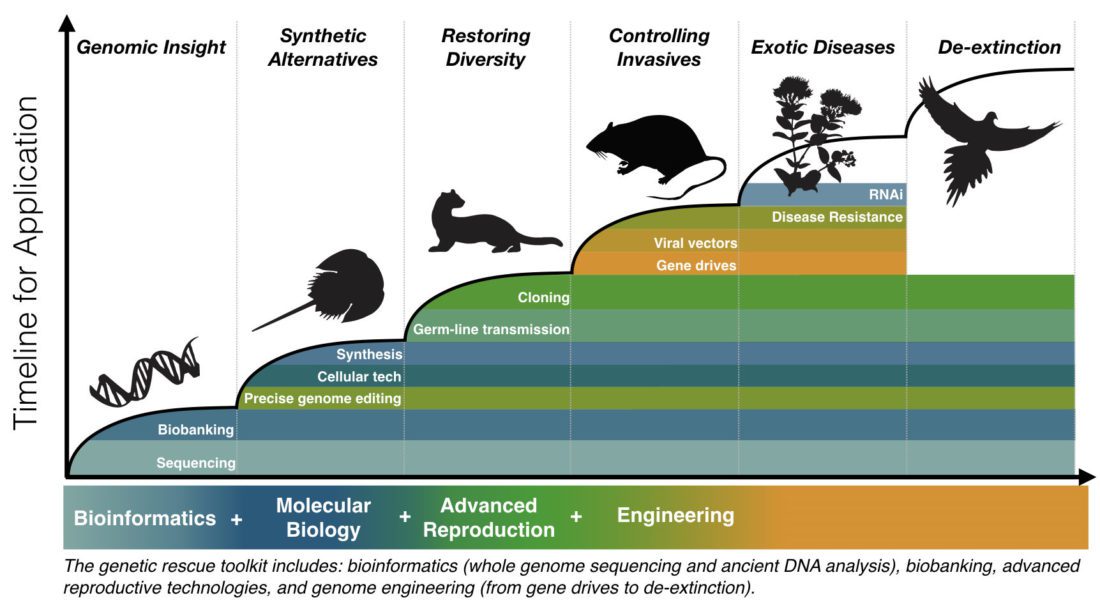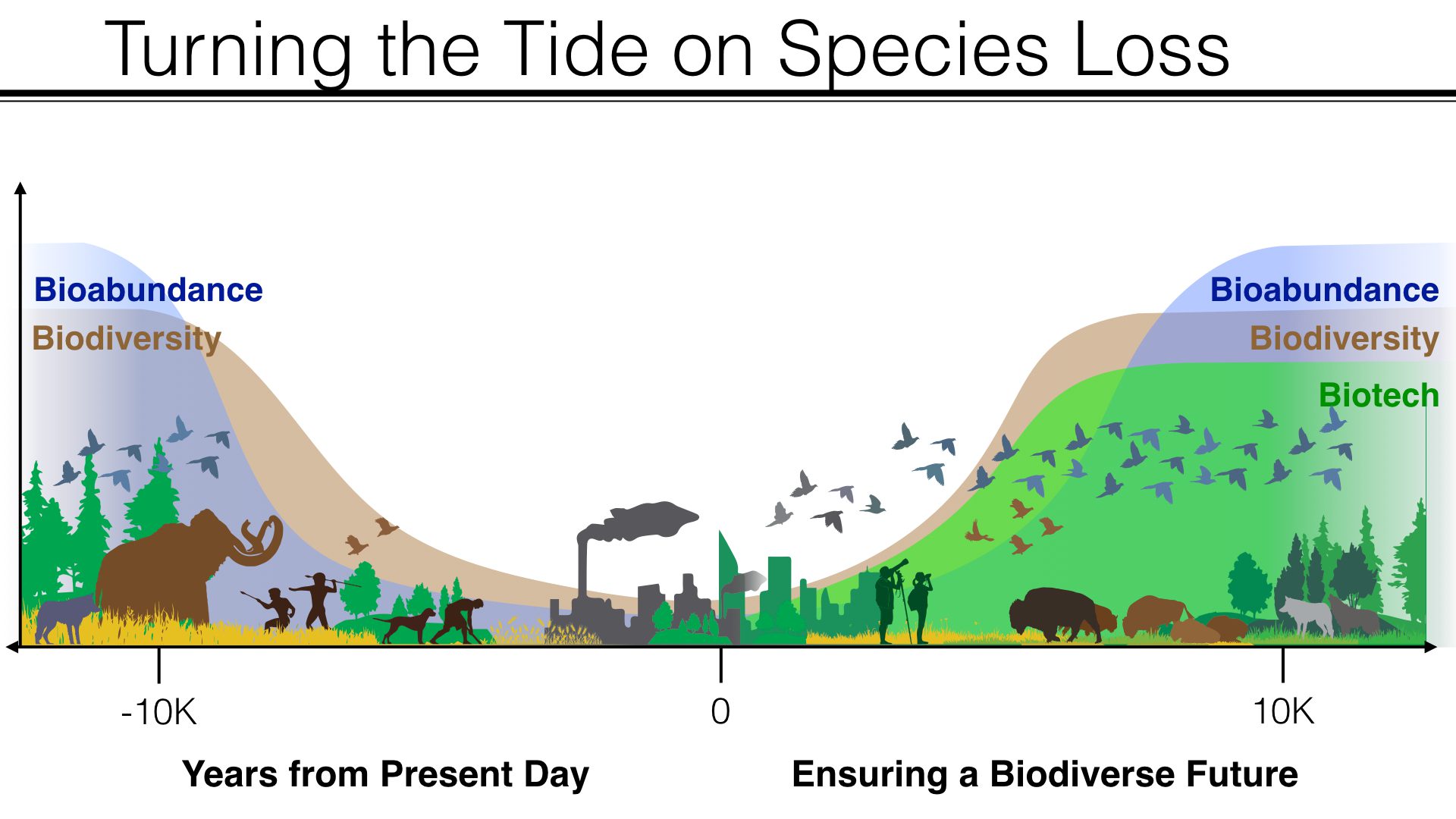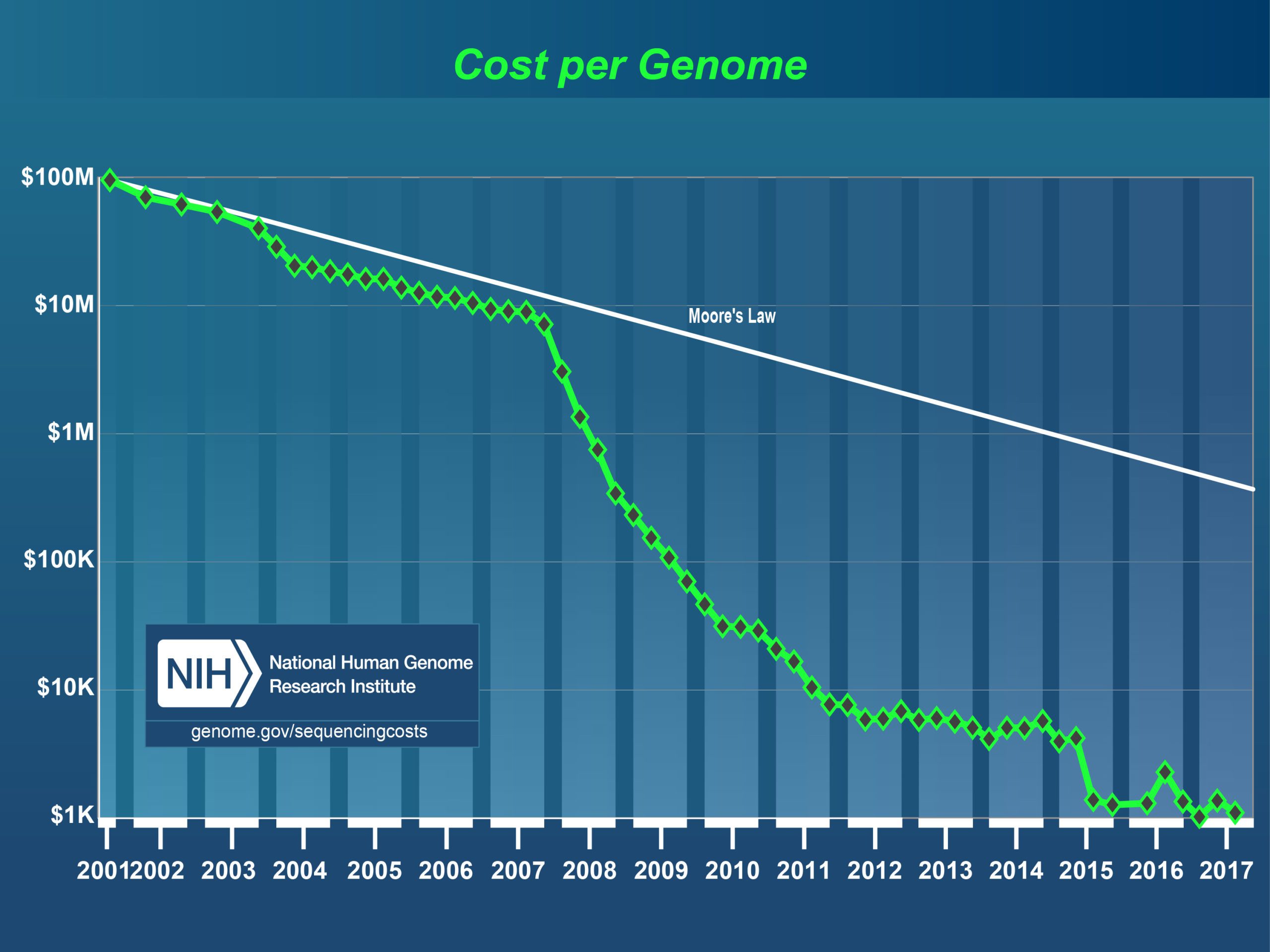This article was originally published on January 17, 2018 by the World Economic Forum as part of the WEF 2018 Annual Meeting.

Written by:
Nishan Degnarain
National Ocean Council of the Government of Mauritius
Ryan Phelan
Co-founder and Executive Director
Revive & Restore
Thomas Maloney
Director of Conservation Science
Revive & Restore
We are facing a global biodiversity crisis. Tens of thousands of animal species are becoming extinct every year, scientists estimate. Almost half the world’s biodiversity has disappeared since the 1970s, according to the Living Planet Index.
These troubling trends show no sign of slowing down. Indeed, population and economic growth, widespread habitat destruction, invasive species, wildlife diseases, and climate change increase the pressure.

Image: Revive & Restore
To safeguard our planet’s biodiversity, we need innovative new approaches. Fortunately, the Fourth Industrial Revolution’s rapid advances in biotechnology tools are already being used in medicine and agricultural systems, particularly in crops and domestic animals. Biotechnology is advancing at an even faster rate than that of Moore’s Law, which saw microchip processing power double every two years while costs fell by half.
As the Carlson curve above shows, the cost of sequencing a genome has fallen from $100 million in 2001 to below $1,000 today. We are now able not just to read biological code faster, but also to write and design with in it new ways.
Here are nine new or emerging biotechnologies which could safeguard nature.
1. Biobanking and Cryo-preservation
Biobanks store biological samples for research and as a back-up resource to preserve genetic diversity. Examples include the San Diego Frozen Zoo, the Frozen Ark projects, and numerous seed banks. Samples provide tissues, cell lines, and genetic information that can form the basis for restoring and recovering endangered wildlife. To enable this, ongoing collection of biological samples from species facing extinction must take place.
2. Ancient DNA
Ancient DNA (aDNA) is DNA that has been extracted from museum specimens or archeological sites, and which is up to thousands of years old. DNA degrades rapidly over time, so most aDNA comes from samples younger than 50,000 years old and is from cold climates. The oldest specimen recorded with retrievable DNA is a horse unearthed from frozen ground in Yukon, Canada; it has beeb dated to between 560,000 and 780,000 years old.
For conservation purposes, aDNA can provide insight into evolution and population genetics, and it can reveal deleterious mutations that have developed over time. It may also allow scientists to recover of valuable “extinct alleles,” in order to return full genetic diversity to species that have been genetically depleted by small or fragmented populations. There is even the prospect of returning important extinct species to life and their old ecological roles in the wild.
(PS. Sorry, no dinosaurs. “You cannot clone from stone.”)
3. Genome sequencing
High-throughput genome sequencing creates a reference genome that can provide the foundation for understanding of a species genetically and that can act as the building blocks for future genetic engineering. Several initiatives are focused on sequencing life on Earth to create an unprecedented resource to capture the genetic diversity of life. Genome 10K, the Fish-T1K (transcriptomes of 1,000 fishes), and the Avian Genomes Project are notable examples.
Rapid sequencing tools, with lower coverage than a reference genome, can be used to study populations cost-effectively. They can provide insight for conservation planning, improve fisheries and wildlife regulation, and enhance restoration outcomes. Genome-based evaluations of populations of widespread but at-risk species such as the jaguar can inform translocations and corridor planning.
Advanced genome sequencing enables researchers to identify the genetic markers that convey resistance to disease or other elements of adaptive fitness.
4. Bioinformatics
Bioinformatics – the merging of data processing, big data, artificial intelligence and biology – provides new scientific insights to inform and guide conservation endeavors. It enables genomics, proteomics, transcriptomics – the sciences of genomes, proteins, and RNA transcripts, respectively. Increasing computing power enables faster analysis of the genetic precursors to adaptation, resilience to environmental change, and relatedness in wild species.

Image: Revive & Restore
5. Genome Editing
Advances such as CRISPR has made genome editing much more precise and accessible in the past five years. Wildlife managers now have a targeted way to activate disease resistance that may be dormant. It is also possible to “knock in” genetic traits from another species, enabling resistance to new diseases. For example, genome editing could accelerate the development of fragile and endangered coral reef systems, making them more resilient to warmer and more acidic oceans.
6. Gene Drive
The invasion of non-native pest species, such as rodents, feral pigs, and insects, represents a significant global threat to biodiversity, especially on biodiversity-rich small islands. Traditional approaches to eradicating non-native invasive species usually involve powerful biocides that can have harmful off-target effects. New genetic tools may help.
A gene drive is the process by which a particular gene or gene variant is inherited at a high frequency. For example, to address the problem of invasive rodents, a gene drive could be applied to alter the sex ratio of an island population of rats so that they become all male and fail to breed. Advancements in this technology can allow such traits to be adjustable, regional, and reversible.
Gene drive technology could also be used to eradicate disease. It now looks possible to eliminate a mosquito’s ability to carry human diseases like malaria, zika, and dengue fever, as well as wildlife diseases such as avian malaria.
If responsibly applied, gene drives represent a potentially transformative new tool. However, the high inheritance of the drive makes field application of gene drive technology understandably controversial. Fortuitously for conservation, several different types of gene drive are in development, deploying different methodologies to avoid the spread of the drive beyond the target population.
7. Advanced Reproductive Technologies
Genomics, advanced reproductive techniques, and cloning are becoming widely applied in the animal husbandry sector, particularly in the production of bulls for cattle breeding and for top-performing equine athletes in polo and show jumping. If tissues have been cryopreserved, cloning can bring new genetic diversity to critically imperiled species as well as those that have suffered through a population bottleneck. Cloning provides new hope for several species of Mammal, including the Black-footed Ferret of North America, the Bucardo in Europe, and Northern White Rhinoceros in Africa. For birds, cloning is not possible, but an ingenious workaround using primordial germ cells has been proven in domestic chickens and can be developed for wild birds.
8. Double-stranded RNA
Global trade and travel inadvertently introduce fungal diseases to landscapes and species that lack an evolved defense. New genomic technologies have emerged that provide a suite of potential tools to convey disease resistance and to reduce the virulence of an infection. In particular, short, double-stranded RNAs (dsRNAs) are emerging as a powerful disease management tool.
There has been significant commercial investment to develop this technology for the control of various fungal diseases that threaten agricultural production. dsRNAs offer an effective, environmentally friendly way to control specific pathogenic species with few off-target effects. Bat populations in North America have crashed due to a fungal pathogen known as White-Nose Syndrome. This technology could enable these bats to survive and recover.
9. Synthetic Alternatives to Wildlife Products
Overuse of natural products for biomedical and consumer use continues to cause or threaten extinctions. Synthetic biology offers new manufacturing methods to supplant and displace the demand for wildlife products. For instance, Horseshoe Crabs, which are harvested and bled for a unique protein used in the safety testing of injectable drugs and vaccines, could be replaced by a synthetic alternative.

Image: Revive & Restore




